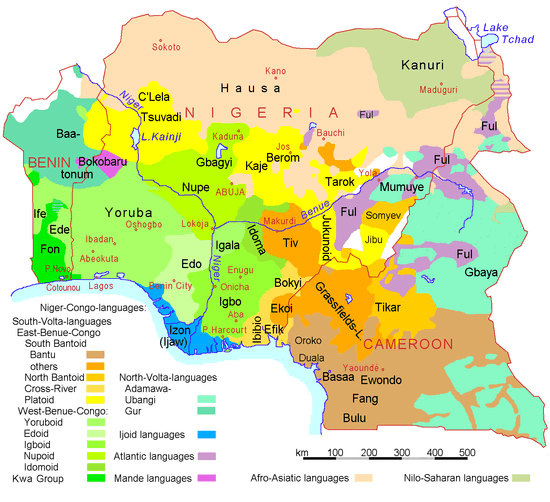Bantoid languages
| Bantoid | |
|---|---|
| (dubious) | |
| Geographic distribution: | Subsaharan Africa, but not further west than Nigeria |
| Linguistic classification: |
|
| Subdivisions: | |
| Glottolog: | bant1294[1] |
|
Northwestern edge of the Bantu area (brown) and other Bantoid languages (strong and middling orange) in Nigeria and Cameroon | |
In the classification of African languages, Bantoid is a putative branch of the Benue–Congo branch of the Niger–Congo family. The term 'Bantoid' was first used by Krause in 1895 for languages that showed resemblances in vocabulary to Bantu. Greenberg in his 1963 The Languages of Africa defined Bantoid as the group to which (Narrow) Bantu belongs together with its closest relatives; this is the sense in which the term is still used today. The Bantoid languages probably do not actually form a coherent group.[2]
A proposal that divided Bantoid into North and South Bantoid was introduced in Williamson (1989, based on work presented in Blench [1987]). In this proposal, the Mambiloid and Dakoid languages (and later Tikar) are grouped together as North Bantoid, while everything else Bantoid is subsumed under South Bantoid; the Ethnologue uses this classification. The legitimacy of the North Bantoid group is questionable, and the Dakoid languages are often now placed outside Bantoid, but the work did establish Southern Bantoid as a valid genetic unit. Southern Bantoid includes the well known and numerous Bantu subfamily.
References
- ↑ Hammarström, Harald; Forkel, Robert; Haspelmath, Martin; Bank, Sebastian, eds. (2016). "Bantoid". Glottolog 2.7. Jena: Max Planck Institute for the Science of Human History.
- ↑ Roger Blench. "Niger-Congo: an alternative view" (PDF). Rogerblench.info. Retrieved 2013-10-16.
Bibliography
- Blench, Roger [1987] 'A new classification of Bantoid languages.' Unpublished paper presented at 17th Colloquium on African Languages and Linguistics, Leiden.
- Williamson, Kay (1989) 'Niger–Congo Overview'. In: The Niger–Congo languages, ed. by John Bendor-Samuel, 3–45. University Press of America.
- Williamson, Kay & Blench, Roger (2000) 'Niger–Congo', in Heine, Bernd and Nurse, Derek (eds) African Languages – An Introduction. Cambridge: Cambridge University press, pp. 11–42.
